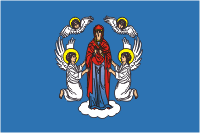Minsk
Minsk (Belarussian: Мінск, Minsk[1] [mʲinsk] or sometimes Менск, Miensk [mʲɛnsk][2]; Russian: Минск, Minsk [mʲinsk]) is the capital and largest city in Belarus, situated on the Svislach and Niamiha rivers. Minsk is also a headquarters of the Commonwealth of Independent States (CIS). As the national capital, Minsk has a special administrative status in Belarus and is also the administrative centre of Minsk voblast (province) and Minsk raion (district). It has a population of 1,830,000 inhabitants (2008).
The earliest references to Minsk date to the 11th century (1067), then a provincial city within the principality of Polotsk. In 1242, Minsk became a part of the Grand Duchy of Lithuania, and it received its town privileges in 1499. From 1569, it was a capital of the Minsk Voivodship in the Polish-Lithuanian Commonwealth. It was annexed by Russia in 1793, as a consequence of the Second Partition of Poland. From 1919–1991, Minsk was the capital of the Byelorussian SSR.
Geography and climate
Minsk is located on the southeastern slope of the Minsk Hills, a region of rolling hills running from the southwest (upper reaches of the river Nioman) to the northeast - that is, to the Lukomskaye lake in northwestern Belarus. The average altitude above sea level is 220 m. (721.78 ft.) The geography of Minsk was formed during the two most recent Ice Ages. The Svislach river, which flows across the city from the northwest to the southeast, is located in the urstrohmtal, an ancient river valley formed by water flowing from melting ice sheets at the end of the last Ice Age. Minsk was initially founded on the hills. However, in the 20th century, it grew to include the relatively flat plains in the southeast. The western parts of the city are the most hilly.
Minsk is located in the area of mixed forests typical for most of Belarus. Pinewood and mixed forests are still present at the edge of the city, especially in the north and east. Some of the forests were transformed into parks (for instance, the Chelyuskinites Park) as the city grew.
Recent Developments
Throughout the 1990s, after the fall of Communism, the city continued to change. As the capital of a newly-independent country, Minsk quickly acquired the attributes of a major city. Embassies were opened, and a number of Soviet administrative buildings became government centers. During the early and mid-1990s, Minsk was hit by an economic crisis and many development projects were halted, resulting in high unemployment and underemployment. Since the late 1990s, there have been improvements in transport and infrastructure, and a housing boom has been underway since 2002. On the outskirts of Minsk new mikroraions of residential development have been built. Metro lines have been extended, and the road system(including the Minsk ring road) has been improved. Owing to the small size of the private sector in Belarus, most development has so far been financed by the government. In January 2008, the city government announced several projects on its official web-site. Among them are the refurbishment of some streets and main avenues, the constructions of more up-to-date hotels (one near the Palace of the Republic and another on the shore of Lake Komsomolkye), the demolition of the out-of-date Belarus hotel and the erection in the same premises of a complex consisting of sport facilities, swimming pool, 2 hotel towers and one business center building with the help of potential foreign investors and the construction of a modern aquatic park in the outskirts of the city. On September 8, 2007, the city of Minsk celebrated 940 years since its founding.
